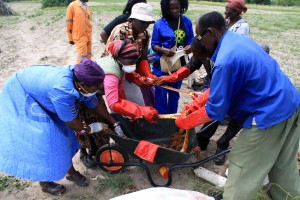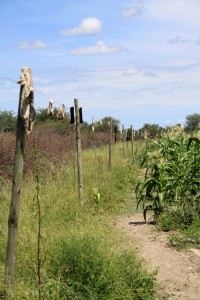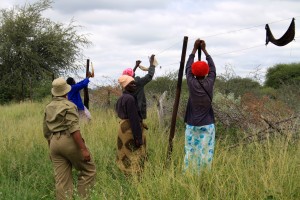Human-Elephant conflict project expands – by Dr Emily Bennitt
February 20, 2014The hazards of fieldwork – By James Stevens
April 11, 2014Chilli Pepper Workshop by James Stevens
Last week Elephants for Africa’s Research Coordinator, Dr Emily Bennitt, and I attended the Department of Wildlife and National Parks (DWNP) Human-wildlife co-existence project workshop. These workshops were being held in two communities on the boundary of Makgadikgadi Pans National Park where their lives are disrupted due to high levels of human-wildlife conflict. This workshop was focussing on human-elephant conflict with the communities being taught about the use of chilli pepper fences to deter elephants from raiding crops.
On the first day we discussed the problems elephants posed to farmers, how chilli pepper can be effective against elephants and how to harvest chilli pepper crops. Initially there was a lot of scepticism about the project. How can a huge animal be afraid of chilli pepper? It couldn’t work. At the end of the first day I left thinking it might be an uphill battle as a project such as this will only work if a community gets behind it.
The second day of the workshop was a practical day and a chance to show the communities how to set up chilli pepper fences, make chilli bricks and grow chilli crops. The farmers were keen to take part and through working together a chilli pepper fence was quickly erected around a field but people were still unsure of the effect. The turning point in the day came when chilli was mixed with cow dung and placed in an Mboala (metal drum) and set on fire. There was nothing for a couple of minutes whilst the dung smouldered. However, the wind picked up and the smoke started to billow. Everyone started coughing and spluttering and it was safe to say there wasn’t a dry eye in the vicinity as everyone ran away from the smoke. Having been told that an elephants sense of smell is 100x better than a humans everyone involved felt this would be successful against elephants.
This workshop has made me feel much more confident about helping to resolve this conflict through my research project. Initially everyone was very against elephants and wildlife in general and all comments directed at elephants were negative. A great moment was when a gentleman who had been very negative about elephants at the beginning and had been saying he would shoot any elephant in his field stood up at the end of the workshop and said ‘that it’s not that he hates elephants but he hates the problems they cause’. He said he felt much better about elephants now that he was shown how to keep them out of his field.
Projects such as chilli pepper fences or beehive fences are in my opinion the answer to human-elephant conflict. Empowering the community so that they feel they can live alongside wildlife can change attitudes in an instance.
We hope to assist the DWNP by monitoring the success of these mitigation strategies put in place to report back to communities if they are stopping elephants and learn more about the elephants that are posing this problem, to reduce the level of conflict, increase community economic stability and increase community involvement in wildlife sustainability.



